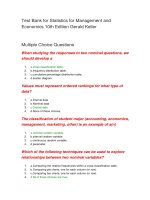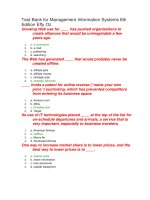Test bank for statistics for management and economics 10th edition gerald keller
Bạn đang xem bản rút gọn của tài liệu. Xem và tải ngay bản đầy đủ của tài liệu tại đây (99.37 KB, 15 trang )
Test Bank for Statistics for Management and
Economics 10th Edition Gerald Keller
Multiple Choice Questions
When studying the responses to two nominal questions, we should
develop a
1.
a.cross-classification table.
2.
b.frequency distribution table.
3.
c.cumulative percentage distribution table.
4.
d.scatter diagram.
Values must represent ordered rankings for what type of data?
1.
a.Interval data
2.
b.Nominal data
3.
c.Ordinal data
4.
d.None of these choices.
The classification of student major (accounting, economics, management,
marketing, other) is an example of a(n)
1.
a.nominal random variable.
2.
b.interval random variable.
3.
c.continuous random variable.
4.
d.parameter.
Which of the following techniques can be used to explore relationships
between two nominal variables?
1.
a.Comparing the relative frequencies within a cross-classification table.
2.
b.Comparing pie charts, one for each column (or row).
3.
c.Comparing bar charts, one for each column (or row).
4.
d.All of these choices are true.
For which type of data are the values arbitrary numbers?
1.
a.Interval data
2.
b.Nominal data
3.
c.Ordinal data
4.
d.None of these choices.
For what type of data are frequencies the only calculations that can be
done?
1.
a.Interval data
2.
b.Nominal data
3.
c.Ordinal data
4.
d.None of these choices.
Car buyers were asked to indicate the car dealer they believed offered the
best overall service. The four choices were Contour Motors (C), Modern
Chrysler (M), Tonneau Auto (T), and Uncanny Chevrolet (U). The following
data were obtained: T C C C U C M T C U; U M C M T C M M C M; T C C T U
M M C C T; T U C U T M M C U T. What percentage of car buyers identified
Contour Motors as having the best overall service?
1.
a.1/4 = 0.25 or 25%
2.
b.14/40 = 0.35 or 35%
3.
c.14%
4.
d.None of these choices.
All calculations are permitted on what type of data?
1.
a.Interval data
2.
b.Nominal data
3.
c.Ordinal data
4.
d.All of these choices are true.
In the following cross-classification table, how are gender and house
ownership related? Own a houseDon't own a house; Females 60 30; Males
80 40.
1.
a.The percentage of house owners is higher for males than for females.
2.
b.The percentage of house owners is higher for females than for males.
3.
c.The percentage of house owners is the same for females and males.
4.
d.You cannot compare percentages for males and females since the total
frequencies are not equal.
The classification of student class designation (freshman, sophomore,
junior, senior) is an example of a(n)
1.
a.nominal random variable.
2.
b.interval random variable.
3.
c.ordinal random variable.
4.
d.a parameter.
Which situation identifies when to use pie charts and/or bar charts?
1.
a.You want to describe a single set of data.
2.
b.Your data is nominal.
3.
c.You want to show the number or the percentage of individuals in each category.
4.
d.All of these choices are true.
Which of the following statements about pie charts is false?
1.
a.A pie chart is a graphical representation of a relative frequency distribution.
2.
b.You can always determine frequencies for each category by looking at a pie
chart.
3.
4.
c.The total percentage of all the slices of a pie chart is 100%.
d.The area of a slice of a pie chart is the proportion of all the individuals that fall
into that particular category.
A statistics professor classifies his students according to their grade
point average (GPA) and their gender. The resulting cross-classification
table is shown below: GPA; Gender Under 2.5 2.5-3.5 Over 3.5; Male 5 25
10;Female 10 20 30. Which of the following describes the relationship
between GPA and gender shown by this table?
1.
a.A higher percentage of females have GPAs over 3.5, compared to males.
2.
b.A lower percentage of females have GPAs over 3.5, compared to males.
3.
c.Females and males each have the same percentage of GPAs over 3.5.
4.
d.You cannot compare male and female GPAs because the total number in each
group is not the same.
Which of the following situations is best suited for a pie chart?
1.
a.The number of dollars spent this year on each type of legal gambling.
2.
b.The percentage of a charitable donation that goes to administrative costs vs.
directly to the charity.
3.
c.The number of students in your class who received an A, B, C, D, F on their
exam.
4.
d.All of these choices are true.
A researcher wishes to estimate the textbook costs of first-year students
at Barry University. To do so, he recorded the textbook cost of 300 firstyear students and found that their average textbook cost was $195 per
semester. The variable of interest to the researcher is
1.
a.textbook cost.
2.
b.class rank.
3.
c.number of students.
4.
d.name of university.
Suppose you measure the number of minutes it takes an employee to
complete a task, where the maximum allowed time is 5 minutes, and each
time is rounded to the nearest minute. Data from 130 employees is
summarized below. How long did it take most employees to complete the
task? Time (minutes)12345; Frequency2540503530
1.
a.5 minutes
2.
b.3 minutes
3.
c.30 minutes
4.
d.50 minutes
True - False Questions
All calculations are permitted on interval data.
1.
True
2.
False
A cross-classification table is the same thing as two frequency
distribution tables, one for each variable.
1.
True
2.
False
From a pie chart you are able to find the frequency for each category.
1.
True
2.
False
The percentage of observations in each combination of the crossclassification table must be equal in order to show two nominal variables
are not related.
1.
True
2.
False
Interval data, such as heights, weights, incomes, and distances, are also
referred to as quantitative or numerical data.
1.
True
2.
False
In the following cross-classification table, gender and fantasy baseball
participation are related. Participate in FantasyDon't participate in
FootballFantasy Football Males7525 Females4555
1.
True
2.
False
A frequency distribution lists the categories and the proportion with which
each occurs.
1.
True
2.
False
Interval data may be treated as ordinal or nominal.
1.
True
2.
False
A variable is some characteristic of a population or sample.
1.
True
2.
False
A bar chart is used to represent interval data.
1.
True
2.
False
Your gender is a nominal variable.
1.
True
2.
False
Your final grade in a course (A, B, C, D, E) is a nominal variable.
1.
True
2.
False
Whether or not you are over the age of 21 is a nominal variable.
1.
True
2.
False
With nominal data, there is one and only one way the possible values can
be ordered.
1.
True
2.
False
The values of quantitative data are categories.
1.
True
2.
False
You cannot calculate and interpret differences between numbers assigned
to ordinal data.
1.
True
2.
False
To describe the relationship between two nominal variables you make a
scatter diagram and look for a correlation.
1.
True
2.
False
In the following cross-classification table, gender and car ownership are
related. Own a carDon't own a car Females6030 Males8040
1.
True
2.
False
Your age group (1-9; 10-19; 20-29; 30-39; etc.) is an interval variable.
1.
True
2.
False
One of the advantages of a pie chart is that it clearly shows that the total
percentages of all the categories add to 100%.
1.
True
2.
False
A cross-classification table summarizes data from two nominal variables.
1.
True
2.
False
If two nominal variables are unrelated, then the patterns exhibited in their
corresponding bar charts should be approximately the same. If some
relationship exists, then some bar charts will differ from others.
1.
True
2.
False
A college professor classifies his students according to their grade point
average (GPA) and their gender. The resulting cross-classification table is
shown below. GPA GenderUnder 2.02.0 - 3.0Over 3.0 Male103015
Female152535 If you made a pie chart for male GPAs and a pie chart for
female GPAs, those pie charts would look the same.
1.
True
2.
False
If the relative frequencies in the rows of a cross-classification table are
similar, then the two variables shown in the table are not related.
1.
True
2.
False
Bar and pie charts are graphical techniques for nominal data. The former
focus the attention on the frequency of the occurrences of each category,
and the later emphasizes the proportion of occurrences of each category.
1.
True
2.
False
Your age is an interval variable.
1.
True
2.
False
Nominal data are also called qualitative or categorical.
1.
True
2.
False
If two nominal variables are unrelated, then the patterns exhibited in their
corresponding pie charts should be approximately the same. If some
relationship exists, then some pie charts will differ from others.
1.
True
2.
False
A relative frequency distribution lists the categories and their counts.
1.
True
2.
False
Free Text Questions
Two types of graphs that organize nominal data are
____________________ and ____________________.
Answer Given
pie chart; bar chart; bar chart; pie chart
In purchasing an automobile, there are a number of variables to consider.
The body style of the car (sedan, coupe, wagon, etc.) is an example of a(n)
____________________ variable.
Answer Given
nominal; categorical; qualitative
In purchasing a used computer, there are a number of variables to
consider. The age of the computer is an example of a(n)
____________________ variable.
Answer Given
interval; quantitative; numerical
Provide one example of ordinal data; one example of nominal data; and
one example of interval data.
Answer Given
Ordinal data example: Response to a market research survey question measured
on the Likert scale using the code: 1 = strongly agree, 2 = agree, 3 = neutral, 4 =
disagree, and 5 = strongly disagree. Nominal data example: Voters’ political party
affiliation for using the code: 1 = Democrat, 2 = Republican, and 3 = Independent.
Interval data example: The temperature on a golf course during the U.S. Master’s
Tournament. (degrees Fahrenheit).
Identify the type of data for which each of the following graphs is
appropriate: a.Pie chart; b.Bar chart
Answer Given
a.Nominal; b.Nominal
A cross-classification table is used to describe the relationship between
two ____________________ variables.
Answer Given
nominal; categorical; qualitative
A pie chart is used to represent ____________________ data.
Answer Given
nominal; categorical; qualitative
You can graph the relationship between two nominal variables using two
____________________ or two ____________________.
Answer Given
bar charts, pie charts; pie charts, bar charts
A(n) ____________________ chart is often used to display frequencies;
a(n) ____________________ chart graphically shows relative frequencies.
Answer Given
bar; pie
The Dean of Students conducted a survey on campus. The gender of each
student is an example of a(n) ____________________ variable.
Answer Given
nominal; categorical; qualitative
In a pie chart, each slice is proportional to the ____________________ of
individuals in that category.
Answer Given
percentage; proportion; relative frequency
A category in a pie chart that contains 50% of the observations is
represented by a slice of the pie that is equal to ____________________
degrees.
Answer Given
180
A(n) ____________________ distribution lists the categories of a nominal
variable and the proportion with which each occurs.
Answer Given
relative frequency
If two bar charts made from the rows of a cross-classification table look
the same, then the two nominal variables ____________________ (are/are
not) related.
Answer Given
are not
Data that contains information on a single variable is called
____________________ data.
Answer Given
univariate
Explain why religious preference is not an ordinal variable.
Answer Given
The values of religious preference cannot be ranked in order in any way.
We can summarize nominal data in a table that presents the categories
and their counts. This table is called a(n) ____________________
distribution.
Answer Given
frequency
A bar chart is used to represent ____________________ data.
Answer Given
nominal; categorical; qualitative
To evaluate two nominal variables at the same time, a(n)
____________________ table should be created from the data.
Answer Given
cross-classification; cross-tabulation; contingency
Explain the difference between ordinal data and interval data.
Answer Given
The critical difference between them is that the intervals or differences between
values of interval data are consistent and meaningful. That is, we can calculate
the difference and interpret the results. Because the codes representing ordinal
data are arbitrarily assigned except for the order, we cannot calculate and
interpret differences.
The final grade received in a Literature course (A, B, C, D, or F) is an
example of a(n) ____________________ variable.
Answer Given
nominal; categorical; qualitative
A(n) ____________________ chart is not able to show frequencies. It can
only show relative frequencies.
Answer Given
pie
Data that contains information on two variables is called
____________________ data.
Answer Given
bivariate
Give an example of interval data that can also be treated as ordinal data
and nominal data.
Answer Given
Example: Your actual age is interval data; your age group (1-17; 18-24; 25-30;
etc.) is ordinal data; and whether or not you are over age 25 is nominal data.
If two pie charts made from the rows of a cross-classification table look
the same, then the two nominal variables ____________________ (are/are
not) related.
Answer Given
are not
A pie chart shows the ____________________ of individuals that fall into
each category.
Answer Given
percentage; relative frequency; proportion
The Chief of Police conducted a survey of the officers on his squad. An
officer’s shooting score at target practice is an example of a(n)
____________________ variable.
Answer Given
interval; quantitative; numerical
The Dean of Students conducted a survey on campus. Class rank
(Freshman, Sophomore, Junior, and Senior) is an example of a(n)
____________________ variable.
Answer Given
ordinal









